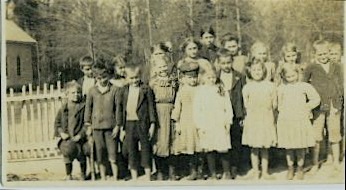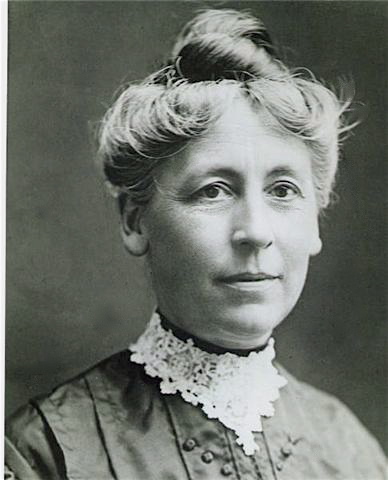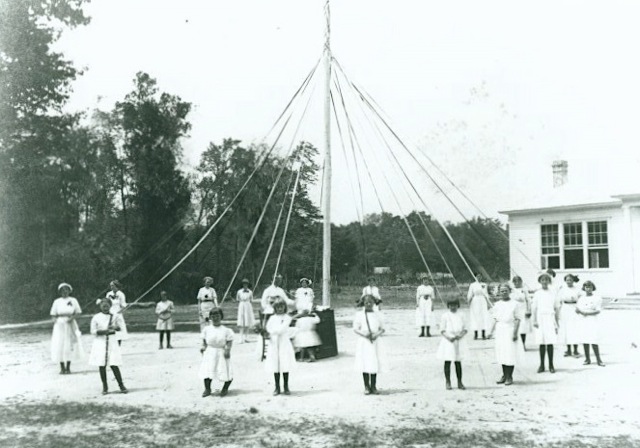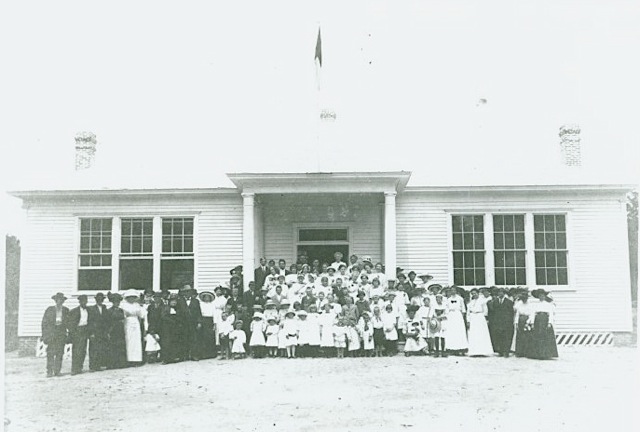
Reminiscing About Shelter Neck
by Norma Rowe Sawyer
(former student and teacher at Shelter Neck
School 1913-1923)
Published in the Tar Heel Universalist in May
1974 << Back to ShelterNeck homepage
It is unfortunate that so much of our heritage is
lost to future generations because those who participated in the
making of it do not have the time to record it for us, or else do
not see the need for recording it for posterity.
For the benefit of my children, and for others
who may be interested, I am recording at this late date my memories
of the Unitarian School in the community of Shelter Neck, Pender
County, North Carolina.
There is no known person living today who knows
why the Unitarians from Boston, Mass., chose this isolated
community, enclosed partially between the waters of Shelter Creek
and the Northeast River, to establish a school.
Mr. Wayne Arnold has been able to trace some of
the history of the purchase of the property by searching through old
deed records. This reveals that a deed was drawn on August 4,
1900, to Mrs. Abbey Peterson and Mrs. Edith Dukes of  Pender County for the purchase of the
tract of land from Mrs. Frances G. Newton and Charles Sears, and
wives, respectively, “for the love of God and humanity and the sum
of $1.00. Mrs. Peterson represented the National Alliance of
Unitarian Women of Boston. I remember my mother stating that
Mr. Dukes was the first Unitarian minister to preach in the chapel,
which was built about 1900.
Pender County for the purchase of the
tract of land from Mrs. Frances G. Newton and Charles Sears, and
wives, respectively, “for the love of God and humanity and the sum
of $1.00. Mrs. Peterson represented the National Alliance of
Unitarian Women of Boston. I remember my mother stating that
Mr. Dukes was the first Unitarian minister to preach in the chapel,
which was built about 1900.
Three-fourths of an acre adjoining the chapel was
purchased July 25, 1907, from M. B. and Charlotte Hanchey “to be
used for advancement of the gospel of God as taught by Jesus of
Nazareth and for the good of humanity.” There may be other
information regarding transfer of property after that date which
could not be located.
During 1905, Mrs. Peterson was joined by Mr. Key,
a minister from Boston.
In the fall of 1913 I enrolled in the school, and
was there until the spring of my 16th birthday in 1923. It was
three miles from my home to the school, and various modes of
transportation were used to travel it. My brother, who also
attended the school as a boy, used his goat and cart.
Sometimes, along with other neighborhood children, we drove the mule
hitched to a cart or buggy. As we grew older, we started
riding our bicycles, and when the weather was nice, we walked.
Traveling in the early morning and late afternoon, as we had to do,
gave us time to observe and appreciate the changing seasons and
natural phenomena of the area.
When I was 10 years old a Mrs. Von Lavner arrived
to teach piano and French. She was living in exile from her
native country, Austria, having escaped from there to Paris, France,
during WWI. She was a member of nobility, and also had been a
student at the leading music conservatories in Europe. From
Paris she migrated to Boston, and then to Shelter Neck. There
she taught 9th grade French, and music to those who would work
hard. Being a perfectionist, she demanded the best of all her
students. When the school was discontinued she went to Alabama
to teach music in a university.
Our history teacher was Mrs. Pratt. She was
a handsome aristocrat, and was related to the Calvin Coolidge
family. I particularly enjoyed having her teach English
History and literature.
 The library housed
many outstanding books, which were sent to the school from
Boston. They enabled me to read extensively from Shakespeare,
Thoreau, Longfellow, Keats, Browning, Shelly, and many more.
It was not unusual for us to put on Shakespearean plays, with the
moss-covered trees serving as the backdrop setting.
The library housed
many outstanding books, which were sent to the school from
Boston. They enabled me to read extensively from Shakespeare,
Thoreau, Longfellow, Keats, Browning, Shelly, and many more.
It was not unusual for us to put on Shakespearean plays, with the
moss-covered trees serving as the backdrop setting.
When we were in our teens my parents decided that
my sister, Gladys, and I should board at the school. The
girls’ dormitory housed 12 girls and three teachers. The boys
roomed on the second and third floors of Dix House. It also
housed the housekeeper, minister, and other teachers.
On a typical school day we arose at 6:00
a.m. One girl built a fire in the stove; another made up the
cots: another filled and trimmed the kerosene lamps; and one would
bring wood in from the pile at the back of the house. Two
girls from each room would set the tables and wash the dishes in Dix
House. The boys had similar duties, and also fed the cows and
chopped the wood. In the dining room there were three tables
with linen tablecloths and napkins, which were changed daily.
French students sat at a table with Miss Von Lavner and
conversed on in French. We always sang the “blessing.”
A school day began with singing and devotionals
in the auditorium. The boarding students went to Dix House at
noontime for a hot meal. The day students ate their lunches
under the trees, and also fed their teams, and played. After
school, the boarding students went to their rooms to rest.
Those who studied piano practiced an hour each day, and had a lesson
twice a week. Study time was from 7:00-9:00 pm, and was
rigidly enforced, and teachers were available to help us with our
studies. At 9:00 p.m. we went to the living room where we were
joined by the teachers in a discussion of things of interest, which
had occurred that day. Also we had read to us some of the
great poems or an inspiring bit of philosophy.
The highlight of a week was the Saturday night
party, where we were taught folk dances. They always concluded
with the Virginia Reel. Young folk from nearby communities
joined with us in our parties.
On Sunday mornings we had church services.
Frequently, these were followed by discussions of our religious
views. Sunday school was held in the afternoon. When the
weather permitted, we would follow this with a leisurely stroll to
the river. On Sunday nights we gathered in the school
auditorium for an hour to sing.
Mrs. Peterson had to be taken to the hospital in
Wilmington early in April 1918. The trip was made in a surrey
over roads which, for the most part, were unpaved. This was a
sad day for all of us, as she did not return. She died on
April 20.
Not very long after the death of Mrs. Peterson,
Mr. Key returned to Boston. Others came from Boston to take
over the school, among which were Mrs. Norton and Mrs. Damon.
When transportation of high school students was
provided by the public school systems, there no longer was a need
for the Shelter Neck school. Consequently, it went out of
existence. However, its influence in the community it served
continues to be felt today.
I deem it a great privilege--and blessing--to
have served as a teacher in the primary grades there during 1924-25.
Norma Rowe
Sawyer

Additional Information:
Norma Rowe Sawyer, former student, became a well-known and
respected teacher in the public schools.
Mrs. Sawyer’s brother, Roy Rowe, also a student at Shelter
Neck, became the director of the Unitarian's Emmerton
School in Swansboro and later became a prominent
businessman, one of the first to build movie theaters in several
towns in NC. He served as President of the Theatre owners of
North and South Carolina for two terms, Board member of the Theatre
Owners of America, and also as Chairman of the NC March of Dimes,
President of the Carolina Aero Club and Chairman of the Burgaw
School Board.
He served for forty years in the NC General Assembly, beginning in
1936 through six terms in the Senate, a term in the House, and eight
years as Principal Clerk of the NC Senate until his retirement in
1976. For 28 years, he was a Trustee of the Greater University
of NC, including service on the Executive Committee. The Association
of Governing Boards of American Universities and Colleges elected
him president.
As a Major in the Civil Air Patrol he helped organize their war
efforts in NC and served as Vice-Commander of the NC CAP and as
their Legislative liaison. He also was the first Chairman of the
Governor’s Council for the Aging.
An active member of the Unitarian Fellowship of Raleigh until his
death, he is buried in the cemetery near the intersection of Highway
117 and US I-40.
More information on Shelter Neck and Emmerton School at
Swansboro:
For her thesis for a Master of Arts Degree in Southern Studies at
the University of Mississippi, Eunice Milton Benton, a graduate of
UNC Chapel Hill NC, researched and wrote, Shelter Neck's
Unitarian School. Copies are in various
libraries, including the Pender County Library and several
university libraries. Eunice retired in the summer of 2011
from her position as District Executive of the Mid-South UU
District. She and her husband were former residents of Winston Salem
where she was a member of the Winston Salem UU congregation.
She resides in Mississippi and a coastal home near Wilmington NC.
Other publications with information about Shelter Neck and the
sister school in Swansboro are in the archives at the Andover
Harvard Theological School Library near Boston and in other
libraries.
<< Back to ShelterNeck homepage


 Pender County for the purchase of the
tract of land from Mrs. Frances G. Newton and Charles Sears, and
wives, respectively, “for the love of God and humanity and the sum
of $1.00. Mrs. Peterson represented the National Alliance of
Unitarian Women of Boston. I remember my mother stating that
Mr. Dukes was the first Unitarian minister to preach in the chapel,
which was built about 1900.
Pender County for the purchase of the
tract of land from Mrs. Frances G. Newton and Charles Sears, and
wives, respectively, “for the love of God and humanity and the sum
of $1.00. Mrs. Peterson represented the National Alliance of
Unitarian Women of Boston. I remember my mother stating that
Mr. Dukes was the first Unitarian minister to preach in the chapel,
which was built about 1900. The library housed
many outstanding books, which were sent to the school from
Boston. They enabled me to read extensively from Shakespeare,
Thoreau, Longfellow, Keats, Browning, Shelly, and many more.
It was not unusual for us to put on Shakespearean plays, with the
moss-covered trees serving as the backdrop setting.
The library housed
many outstanding books, which were sent to the school from
Boston. They enabled me to read extensively from Shakespeare,
Thoreau, Longfellow, Keats, Browning, Shelly, and many more.
It was not unusual for us to put on Shakespearean plays, with the
moss-covered trees serving as the backdrop setting.
